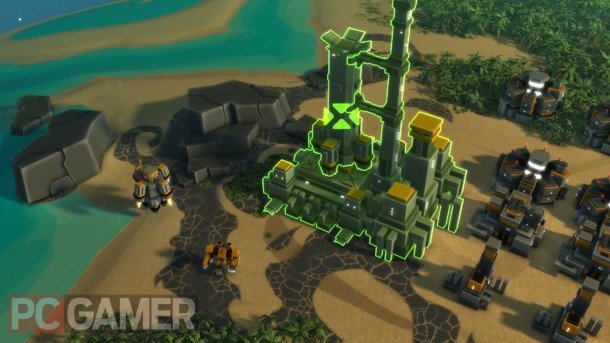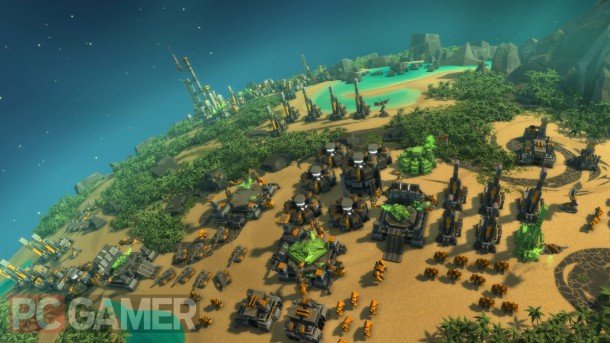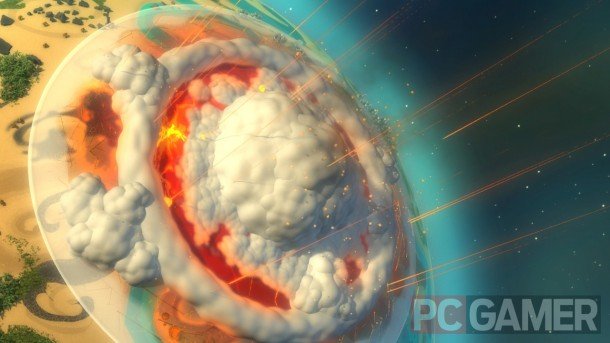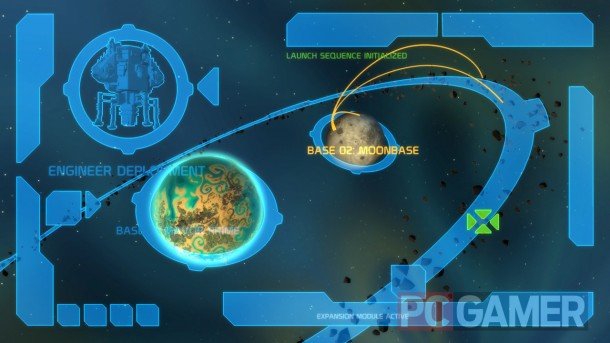
One thing that was always a hallmark of Total Annihilation and Supreme Commander is games like this tend to go really long. They tend to become these huge, sprawling affairs. Will there be persistent saves in multiplayer? If you start playing a big match with people, will you be able to quit, save, and then fire that back up?
Mavor: I'm not sure that we're going to support that. We may support it. But in my experience, the problem with that is... You save the game, and then when do you get all your players back together again? Especially if you match-made into it or something like that. It may not be realistic to be able to restart those. So the question is, is it worth it to put that feature in. You tell me. I mean, one of the things we're doing here is we're going to be reaching out to the fans as we develop the game, to find out what's really important to them.
What I'm picturing for the larger games, honestly, is that we do something... Well, first of all, I want to have a meta-game that it plugs into. I want to do something more organized, where it's like... We spawn off these larger games on a regular schedule, so that if you really want to get involved in a big game, there's a place to go and do it.
Could you elaborate a bit on that meta-game you're thinking about?
Mavor: Yeah. Do you remember where Total Annihilation had the galactic war? The basic idea is that you have a playfield that's made up of, effectively, multiple star systems. Star systems go into contention and you have battles in them. Whichever side wins the battle takes over that system. The goal is to take over the galaxy and win the galactic war. That's what the meta-game is.
Actually, I should talk a little bit about the technology. That has really been my personal forte. I was the lead programmer on Supreme Commander. I wrote most of the graphics engine. I wrote strategic zoom. I wrote the TA graphics engine. My kind of experience on this comes from the tech side. You can see where we're trying to push that with Planetary Annihilation.
To to back up a second... Total Annihilation [multiplayer] was what's called "asynchronous." Chris is a total genius, and he came up with this asynchronous multiplayer idea, where basically, when you played TA, all of the machines in the network had a different view of the game. There was no central server, and there was no one descriptor of the gameplay. It was completely asynchronous. You ran your units, everybody else ran their units, and the network code that this guy Rick Lambright, who's an unbelievable networking genius... He came up with a bunch of code to make all this stuff work. It allowed you to do interesting things. For example, you could run an AI on a particular person's machine. Instead of having everyone run the same AI, you could run it on one person's machine.
The biggest gaming news, reviews and hardware deals
Keep up to date with the most important stories and the best deals, as picked by the PC Gamer team.
With Supreme Commander, we were originally going to go with an async model, but Electronic Arts, when they did the technical review... Basically, they really strongly suggested that we go with what's called a synchronous model. In a synchronous model, what happens is, instead of sending over unit movement around the network, what you send is all the commands that the other players have entered. So for example, what I send to your computer is, I clicked on this unit and gave it this order. What you send over to my computer is, I clicked on this other unit and told it to do something. All of that stuff gets replicated to all the machines, and every single machine runs the simulation in lockstep. We run exactly the same update tick on my machine, your machine, and so on. Well, the implication of that networking model is that if your machine is slow and can't keep up with everyone else's, then you slow us down. In other words, the slowest person actually is the one that controls the performance of the game for everybody else.
"We're going to go with a client-server model. This is the model that most modern games use anyway. But most RTSes don't use this model."
That's an unfortunate situation when you're really trying to push a lot of units and when you're trying to do a lot of stuff with the game. You know you're limited to whatever the slowest machine can do. As opposed to just that person getting a bad experience because they have a slow machine, they make everyone else have a bad experience. What we're doing with Planetary Annihilation is, we're going to go with a client-server model. This is the model that most modern games use anyway. But most RTSes don't use this model.
In this model, you can have really powerful servers that are up in the cloud or in a data center somewhere. You can have a machine that has 32 cores on it running all of the simulation for this massive game. Then your client machine that you're playing on, it only has to deal with the stuff that you can see and the stuff that you want to control. You do the pathfinding for you units, somebody else does the pathfinding for their units, and then the central server does all the heavy lifting to coordinate all that stuff. It's going to allow us to have bigger games than what we can do with the other models. Both from a network bandwidth perspective and from a performance perspective.

I have a note here mentioning that you're planning to integrate something called “mega-games.” These will be like events?
Mavor: Exactly. That's kind of the current thinking, anyway. Imagine that we announce... Okay, this Saturday, every hour, we're going to kick off a game that's like a 40-player game.
Maybe it looks like four or five planets, each with eight to 10 players on it. Think about it from a unit count perspective. You start out and you're like, okay, this server can handle—let's say it's 20,000 units. So when you start out, you have your unit limit, and then as people get knocked out of the game, that unit limit starts getting absorbed by fewer players. By the time you get to just a couple of players left, they each have a huge army, because they've absorbed all the other resources that are there.
The idea is to really be able to have these 12-hour or maybe even 24-hour-long games in some cases, for the people who really want to be involved in a massive battle.
What is your current thinking regarding factions?
Mavor: This is a tough one that we've been going back and forth on. There's basically going to be a single pool of units that everybody can build from. Like, why is there a difference between what the Core have and the Arm have? The war has been going on so long, all the technology should be available to everyone. So differentiating based on faction, in a lot of RTS games, it comes down to the look of the unit. We all have archers, but they look a little different.
We're taking the perspective that you are your own faction. You are your own commander, and you control your own faction. You are trying to win the galactic war. When it gets into the bigger battles, I'm really hoping to be able to fit people's clans and stuff into this, so that people can form their own factions and battle against each other.
But I'll also say that this decision is not 100 percent. In other words, if the fans say, no, we really want to split it up into a couple of factions, we will do that. I'm really curious about this, what the reaction will be to that. It's one of those things that I think is going to be divisive.
What about a campaign?
Mavor: We're not planning on having a campaign. What I am going to do is: people who really want a campaign and they want to support on the Kickstarter, I'm going to make that an option. But the focus here is on massive robot armies battling each other. The campaign is like... You play through the campaign and then you're done. But that cost millions of dollars to make, right? We have to be thrifty here, because we only have so much of a budget. We're not going to have $10 million to make this game, and the campaign is the most expensive stuff to build out of anything.
Let's talk about balancing for a second there. Actually, let's go back one step... If you fire an asteroid at another planet... Are these planet-destroying events? Can you basically raze a planet if you smack something big enough into it?
Mavor: Yes.

Okay. Can you also do more limited damage, where you just devastate maybe a continent?
Mavor: Yeah. Because it's about the relative size and speed of thing coming in. How many engines do you build on it? How big is it? How fast do you get it going before you smack it into the other thing? There's going to be a range of different levels of destruction here. But I would suggest that if you're going to hit a planet, you really want to take it out. Or maybe you want to just take out one half, because all your stuff's on the other half or whatever. There's going to be a range. It's not just going to be an insta-kill, it always destroys the whole planet. It's not that simple.
Also, keep in mind, you want to be able to maneuver these things around. You might not always be moving them just to crash them into something. You might be moving them into different orbits. You can put them in a more strategic location. Things like that.
So you can move a moon into orbit on someone's planet and use it like a huge carrier?
Mavor: Exactly.
About that, though—when I think of Total Annihilation and SupCom, the late game in particular... Sometimes I felt like those games had maybe gotten a little too absurd, where things turned into huge doomsday exchanges, again and again, until someone's knocked out. Which could be a little frustrating, a little dull, because at that point you just keep ordering more missiles and building more heavy artillery. How do you counter that late-game situation?
Mavor: Think about it this way. Imagine that you start off on a planet. You're battling on the planet. You have your commander down there and his commander's down there. Using two of you as an example. You're building up your base, but you're like, "I've got to get my commander off this planet, it's a sitting duck." So I'm picturing games that end where basically two-thirds or three-quarters of the way through the game, the planet's out of it. Your playfield just shrunk, because you guys have chucked enough rocks down at the thing that you can't really do anything with it anymore. Now your playfield has shrunk and you're forced to engage each other.
So picture a scenario where, if you happen to get out there and catch some other commanders on that planet and you take them out, great. But it's usually like, okay, we moved our commanders out-system to hide them. That creates a bit of a cat-and-mouse game as we fight out there. So I think there's going to be some really interesting strategies and scenarios that come out.
Also, our creative director at Uber, John Comes, he worked on Supreme Commander, but he also comes from Westwood. He worked on Command & Conquer Generals: Zero Hour and stuff like that. He's kind of a balance wizard. So he's got some ideas on how to get this game balanced. I don't know if I can speak to all the things he's going to do, but...

I just want to touch on interface once again... You had some criticisms of Supreme Commander. Interface is one of those things that can make or break an RTS. I'm curious about what your design principles are as you're building this interface.
Mavor: Simplicity. Simplicity is the driving goal. And when I say "simplicity," I don't mean necessarily that it's easy. But it's non-complicated. Let me give you some examples. Units should basically do one thing well. If you tell a unit, hey, I want you to go and patrol, say... We're still going to do the shift-click thing where you can stack unit orders. But we want to have a standard set of interfaces for each unit. TA did this really well. You had the state button, which was like... Stay where you are, or stay where you are but fire, or fire at will. That's simple, and every unit consistently maps to that simplicity. You're not going to click on a unit and see 10 custom buttons on this unit that can do 10 different things.
With three-dimensional planets, with planets being spheres, are you worried at all about people getting disoriented as they move around these maps?
Mavor: Yeah, actually. So what we're doing in this game, the actual topology of these planets is not what it appears to be. I don't know if I want to say much more than that, but the actual flow of them, as you move around them, is much more like a rectangular wrapping battlefield than it is like an actual round planet. It looks like a planet, but it's not necessarily going to act like one.
I think that covers most of the questions I have. Is there something that you wanted to bring up that we haven't gotten to?
Mavor: Well, I think the elephant in the room here is... I'm not the guy that designed TA or designed SupCom. That was Chris [Taylor]. He should take full credit for that. I was a tech guy. I've been a tech guy for a long time. We have a lot of people here that worked on those games, but we're not Chris. I honestly don't know what his reaction to this is going to be.
Chris is a creative genius. Imitation is the sincerest form of flattery and all that. I have felt passionate enough about these kinds of games that I want to make another one. That's what it comes down to. It's not meant as a thing to thumb our nose at Chris or anything like that. I love Chris. I think he's a great guy who makes great games. It's just... I want to do my own version of this stuff.
All done? Come read our full preview , which includes some more screenshots of Planetary Annihilation.

